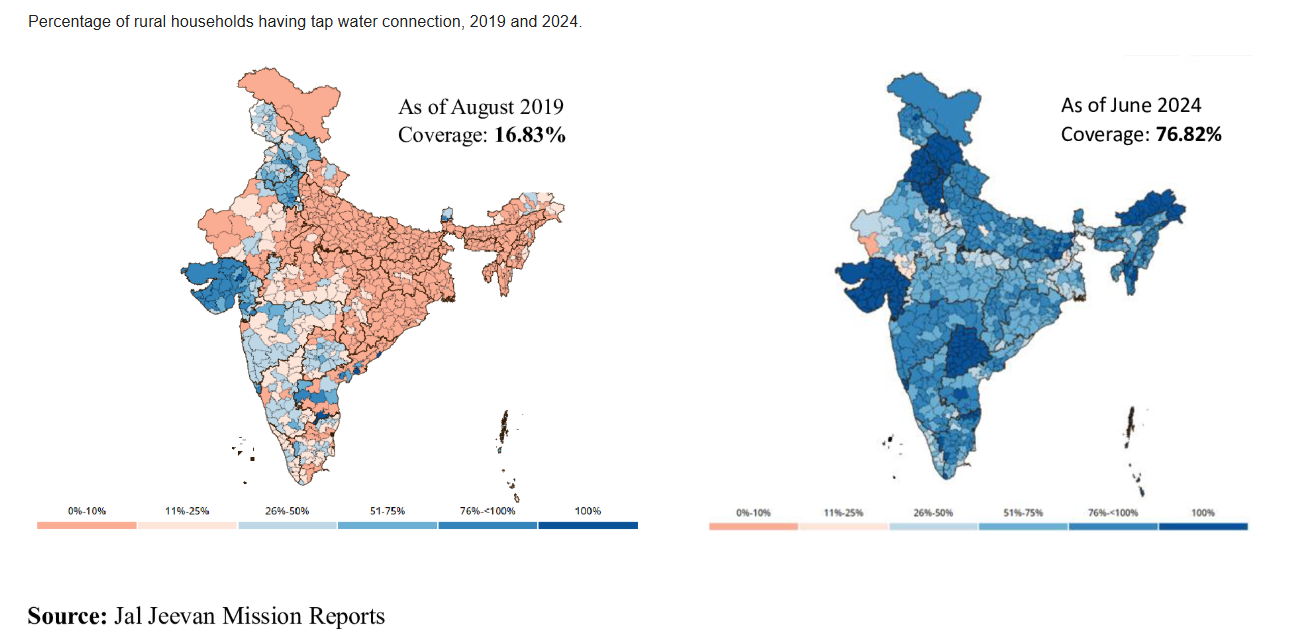Social Justice
India’s Blueprint for Clean Drinking Water
- 29 Apr 2025
- 12 min read
For Prelims: Waterborne diseases, Jal Jeevan Mission, Atal Mission for Rejuvenation and Urban Transformation, Central Water Commission
For Mains: Challenges of water governance in India, Role of urbanization and infrastructure in water scarcity, Water resource management
Why in News?
The Ministry of Housing and Urban Affairs, in line with ‘Viksit Bharat @2047’ vision, has unveiled a blueprint to ensure clean drinking water directly from taps across India.
- The plan shifts focus from bottled water and tankers to building sustainable water treatment systems and robust infrastructure for reliable supply in both urban and rural areas.
What are the Objectives of the Blueprint on Clean Drinking Water for All?
- Safe Drinking Water: The plan aims to move away from bottled water and water tankers by providing direct access to clean, safe drinking water from taps in both urban and rural areas.
- Strengthening Water Treatment Infrastructure: The blueprint focuses on upgrading and expanding water treatment plants and distribution networks to ensure a sustainable and reliable water supply.
- It seeks to improve water quality to reduce the incidence of waterborne diseases and contamination risks across the country.
- Smart Water Management Systems: The blueprint incorporates digitization of water infrastructure by using smart meters, sensors, and remote monitoring systems to track water use, detect leakages, and optimize distribution.
- Water Recycling Initiatives: The plan targets recycling 10,000 million litres per day (MLD) of water for agriculture, industrial, and urban use.
- It also encourages industries to adopt water recycling technologies to promote sustainable operations.
- The plan promotes reuse of treated water in agriculture to reduce pressure on freshwater sources and encourages adoption of water-efficient farming practices.
- Revival and Restoration of Water Bodies: The initiative focuses on restoring lakes, ponds, rivers, and traditional wells to boost water storage, improve quality, and recharge groundwater.
- It promotes the creation of green urban infrastructure with permeable surfaces to naturally absorb rainwater and reduce runoff.
What is the Status of Drinking Water Access in India?
- Access to Basic Drinking Water: In 2020-2021, 95% of rural and 97.2% of urban populations had access to improved sources of potable water.
- Groundwater Dependency: Groundwater accounts for 85% of drinking water in rural areas and 48% in urban areas.
- This reliance on groundwater comes from over 30 million access points (e.g., hand pumps and tube wells).
- Tap and Piped Water: As of February 2025, the Jal Jeevan Mission (JJM) has provided tap water connections to a total of 15.44 crore households, covering 79.74% of rural households in India.
- This marks significant progress toward ensuring universal access to clean drinking water, with a continued focus on achieving 100% coverage.
- In urban areas, piped water supply coverage was 71% in 2011, and by 2019, 93% of India's urban population has access to basic water supply.
- The Atal Mission for Rejuvenation and Urban Transformation (AMRUT) launched in 2015 aimed at universal piped water supply. By November 2023, 1.73 crore new tap connections were provided.
- AMRUT 2.0, targets 100% functional tap connections and water security by 2026, with a focus on 24x7 pressurized water supply systems (PWSS) and "drink from tap" facilities.
What are the Challenges in Accessing Drinking Water in India?
- Water Scarcity: India, despite being home to 17% of the world’s population, has only 4% of the world’s freshwater resources. This creates a significant gap between water demand and supply, especially as demand is expected to exceed available resources by 256 billion cubic meters (BCM) by 2050.
- The Central Water Commission estimates per capita availability at 1,486 m³ in 2021, projected to drop to 1,367 m³ by 2031.
- India is already a water-stressed nation (below 1,700 m³ per capita) and risks becoming water-scarce (below 1,000 m³ per capita) without urgent action.
- Urban Pressures: Rapid urbanization leading to over-extraction of groundwater, and water contamination. Many urban poor rely on private tankers or unsafe sources.
- Issues with Water Governance: The NITI Aayog Composite Water Management Index shows that 16 states scored below 50/100, indicating poor water management.
- Water governance in India is top-down and engineering-driven, focused on building dams and extracting groundwater, ignoring river system health and catchment sustainability.
- Policies in India have primarily focused on increasing water supply through dams, pipelines, and borewells, while neglecting demand management, such as water-use efficiency in agriculture and urban conservation.
- As a result, cities like Bengaluru still face severe water shortages due to rising demand and wastage, despite expanding supply systems.
- Infrastructure Gap: Only 21.4% of households have piped drinking water according to the National Sample Survey Office’s (NSSO) 76th round, and just 28% of urban wastewater is treated, leaving the rest to pollute water bodies.
- India faces a water crisis due to aging infrastructure, rapid population growth, and unplanned urbanization.
- Upgrading water systems needs heavy investment and interstate coordination, further strained by the JJM’s budget cut from Rs 9.10 to Rs 8.68 lakh crore, impacting states like UP, Rajasthan, and MP.
- Groundwater Depletion: Overexploitation of groundwater in India, driven by policies like free electricity, depletes water resources, particularly in agriculture-heavy regions.
- This leads to reduced access to safe drinking water, increases contamination risks, and makes it harder to meet the growing demand for potable water.
- Water Quality: Most Indian cities discharge untreated sewage into water bodies, severely degrading water quality. A survey shows only 6% of urban households receive drinkable water from municipal sources, while 62% depend on purifiers.
- Alarmingly, Nonylphenol, a toxic endocrine-disrupting chemical, has been detected in drinking water samples across India, yet India lacks specific standards to regulate it.
- Behavioral Change: Public habits, such as water wastage and inadequate sanitation practices, hamper the effectiveness of government initiatives like the JJM and Swachh Bharat Abhiyan in ensuring sustainable access to clean drinking water.
What Measures can India Take to Ensure Clean Drinking Water for All?
- Puri's 24-Hour Tap Water Initiative: Puri, Odisha has become the first city in India to provide high-quality, 24x7 drinking water directly from taps under the 'Drink from Tap' project.
- This initiative sets a model for other cities to upgrade water infrastructure and ensure safe, continuous access to potable water.
- Climate Resilience: Invest in climate-resilient water infrastructure such as flood-resistant embankments and levees, desalination plants, rainwater harvesting systems, and floodwater storage reservoirs.
- Integrate climate adaptation strategies into water planning to address erratic rainfall and frequent droughts.
- Revival of Water Bodies: Restore rivers, lakes, and ponds through community-driven conservation models, as seen in the Namami Gange Programme.
- Focus on catchment area protection and soil conservation to enhance water storage capacity.
- Enhance community participation, in water management through Village Water & Sanitation Committees (VWSCs),
- Technological Innovation: Scale up solar-powered water purification systems and reverse osmosis (RO) technologies for rural and urban areas.
- Expand smart water management systems using IoT, sensors, and AI for real-time monitoring and leak detection.
- Policy and Legal Reforms: Implement user-pays water pricing, ensuring sustainable consumption.
- Focus on demand-side management in agriculture by incentivizing water-efficient practices such as Drip Irrigation, development of aquaponics farms and reducing subsidies for water-intensive crops.
Conclusion
India can ensure clean drinking water for all by 2047 through strategic governance reforms, leveraging technology, promoting water reuse, restoring water bodies, and preparing for climate change impacts. These measures require a multi-dimensional approach integrating policy, technology, and community involvement.
|
Drishti Mains Question: Water for All: Pipe Dream or Achievable Reality?”, examine India’s roadmap to universal drinking water access. |
UPSC Civil Services Examination, Previous Year Question (PYQ)
Prelims:
Q.1. Which one of the following ancient towns is well known for its elaborate system of water harvesting and management by building a series of dams and channelizing water into connected reservoirs? (2021)
(a) Dholavira
(b) Kalibangan
(c) Rakhigarhi
(d) Ropar
Ans: A
Q.2. With reference to ‘Water Credit’, consider the following statements: (2021)
- It puts microfinance tools to work in the water and sanitation sector.
- It is a global initiative launched under the aegis of the World Health Organization and the World Bank.
- It aims to enable the poor people to meet their water needs without depending on subsidies.
Which of the statements given above are correct?
(a) 1 and 2 only
(b) 2 and 3 only
(c) 1 and 3 only
(d) 1, 2 and 3
Ans: C
Mains:
Q.1 What are the salient features of the Jal Shakti Abhiyan launched by the Government of India for water conservation and water security? (2020)
Q.2 Suggest measures to improve water storage and irrigation system to make its judicious use under the depleting scenario. (2020)





